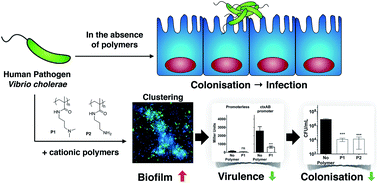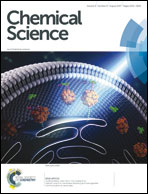Engineering microbial physiology with synthetic polymers: cationic polymers induce biofilm formation in Vibrio cholerae and downregulate the expression of virulence genes†
Abstract
Here we report the first application of non-bactericidal synthetic polymers to modulate the physiology of a bacterial pathogen. Poly(N-[3-(dimethylamino)propyl] methacrylamide) (P1) and poly(N-(3-aminopropyl)methacrylamide) (P2), cationic polymers that bind to the surface of V. cholerae, the infectious agent causing cholera disease, can sequester the pathogen into clusters. Upon clustering, V. cholerae transitions to a sessile lifestyle, characterised by increased biofilm production and the repression of key virulence factors such as the cholera toxin (CTX). Moreover, clustering the pathogen results in the minimisation of adherence and toxicity to intestinal epithelial cells. Our results suggest that the reduction in toxicity is associated with the reduction to the number of free bacteria, but also the downregulation of toxin production. Finally we demonstrate that these polymers can reduce colonisation of zebrafish larvae upon ingestion of water contaminated with V. cholerae. Overall, our results suggest that the physiology of this pathogen can be modulated without the need to genetically manipulate the microorganism and that this modulation is an off-target effect that results from the intrinsic ability of the pathogen to sense and adapt to its environment. We believe these findings pave the way towards a better understanding of the interactions between pathogenic bacteria and polymeric materials and will underpin the development of novel antimicrobial polymers.



 Please wait while we load your content...
Please wait while we load your content...